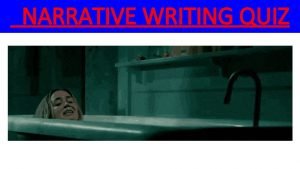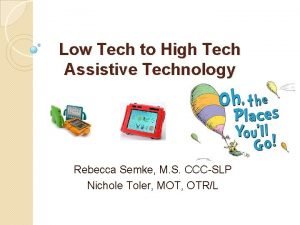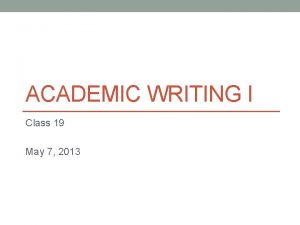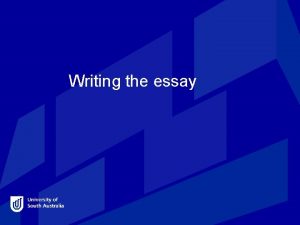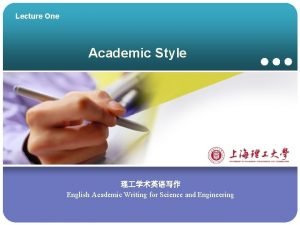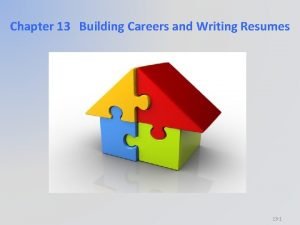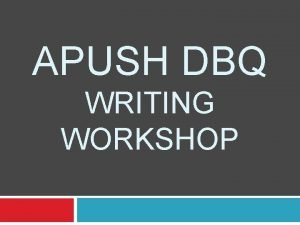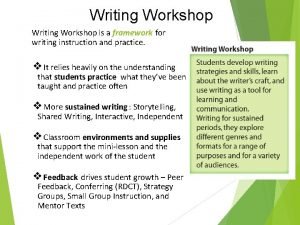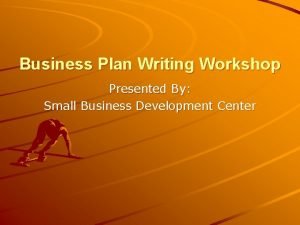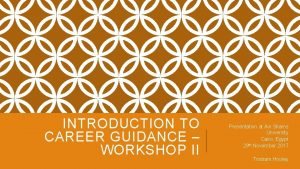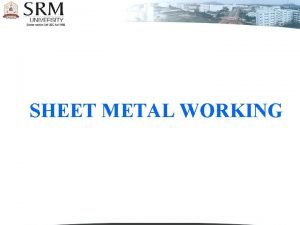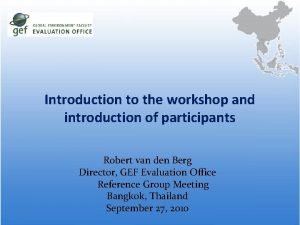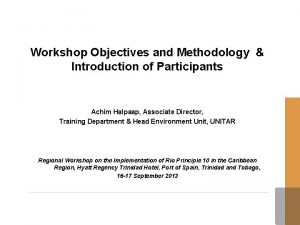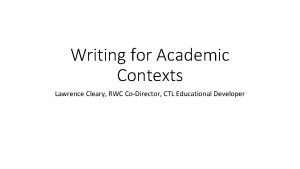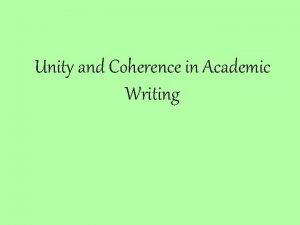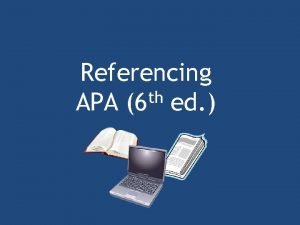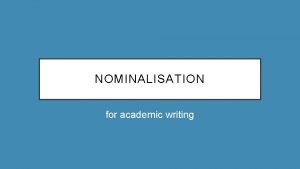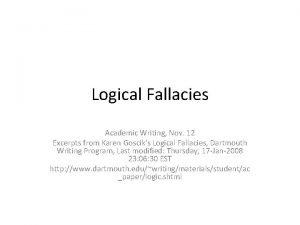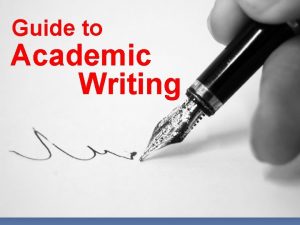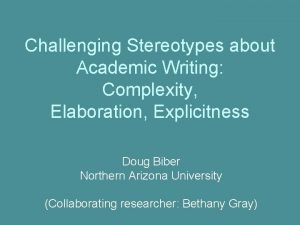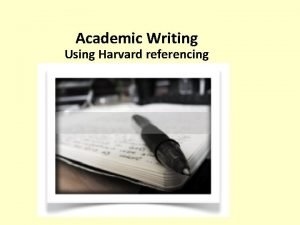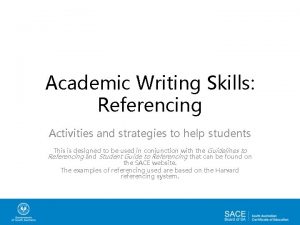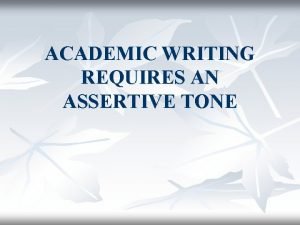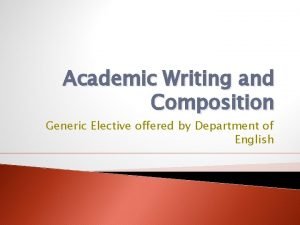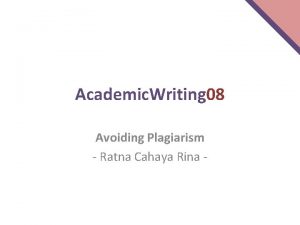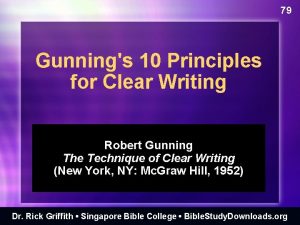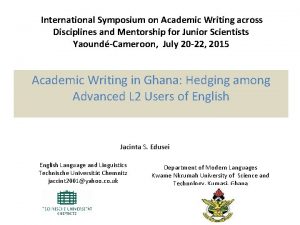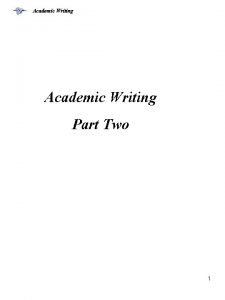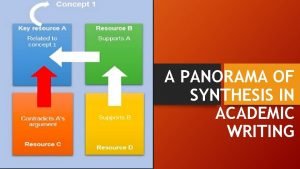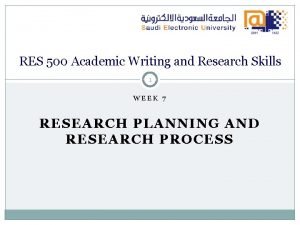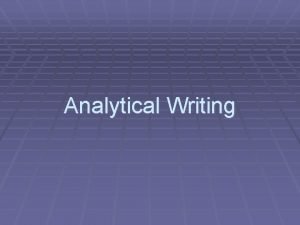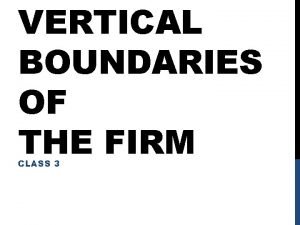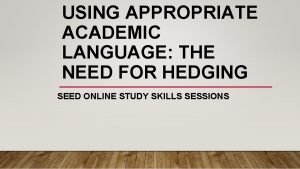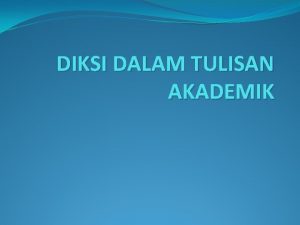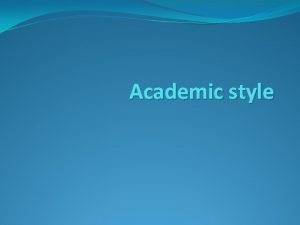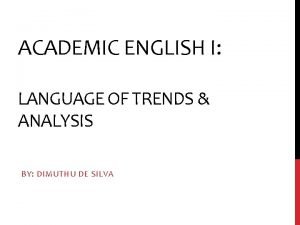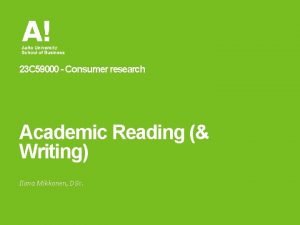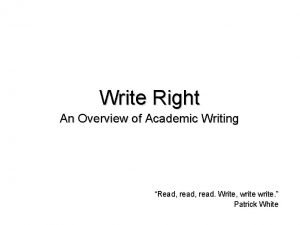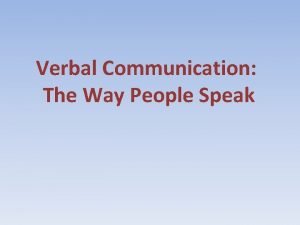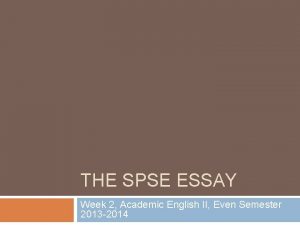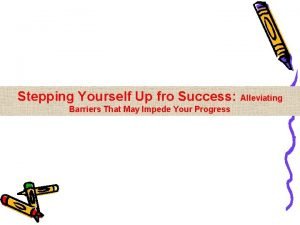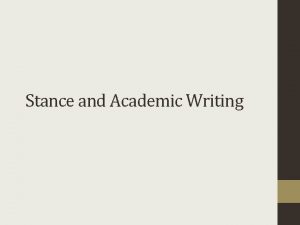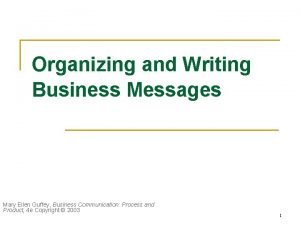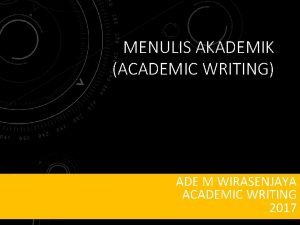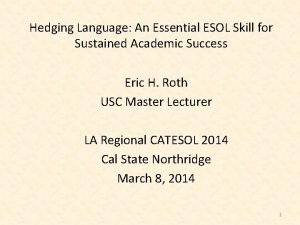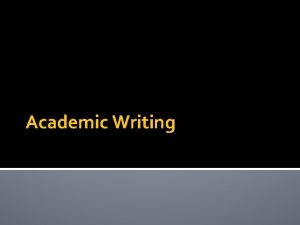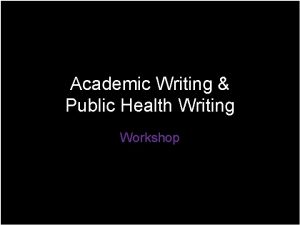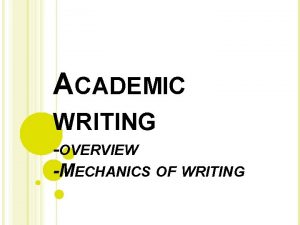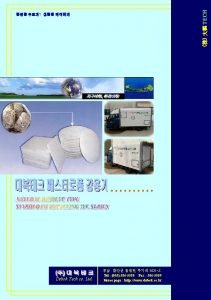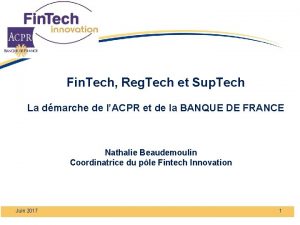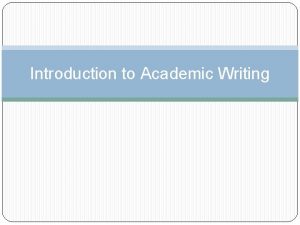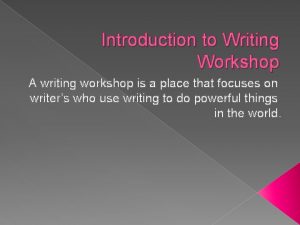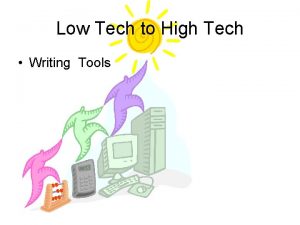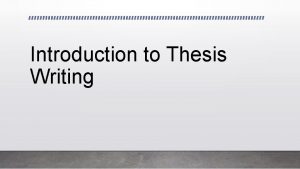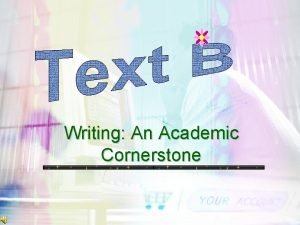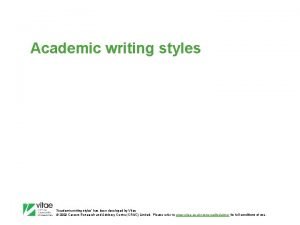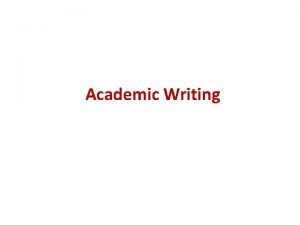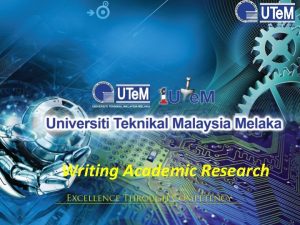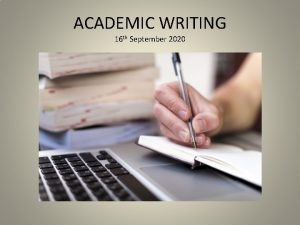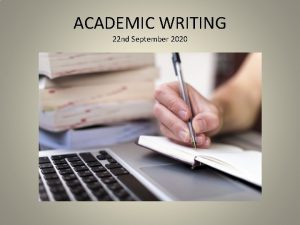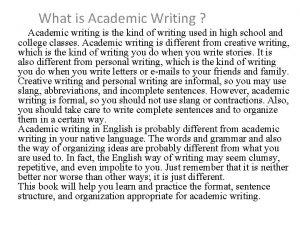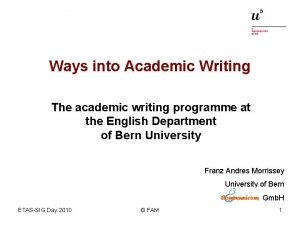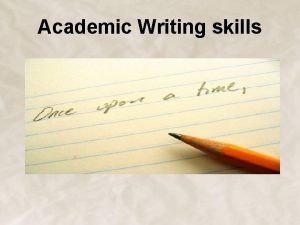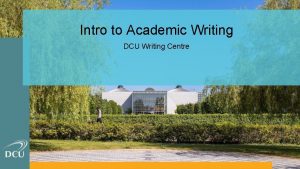Iz Tech Academic Writing Workshop Introduction to Academic



















































- Slides: 51

Iz. Tech Academic Writing Workshop Introduction to Academic Writing Fall, 2019

Workshop Schedule Morning: > Introduction to Academic Writing > 2 Afternoon: Close Readings of Academic Texts

Welcome! Follow along with the slides. Complete exercises in the booklet. You can read the booklet in detail at home. 3

Earn a Workshop Certificate Complete the Academic Writing Workshop Feedback Form. Hand it in to me by the end of the day. Pick up your certificate from the Academic Writing Center (Math 125) next Wednesday (Sep 18). 4

Session 1: Introduction to Academic Writing A. General Approach to Academic Writing B. Introduction to Academic Writing

General Approach to Academic Writing as a Conversation

Exercise 1 (p. 1) Starting with what “They Say” Complete Exercise 1 in your booklet in groups of 3 -4. Share with other groups. 7

Exercise 1 on p. 1 > “Academic writing… calls upon writers not simply to express their own ideas, but to do so as a response to what others have said. …remember that you are entering a conversation and therefore need to start with ‘what others are saying’… and then introduce your own ideas as a response. This is not to say that you must start with a detailed list of everyone who has written on your subject…” - They Say, I Say by Gerald Graff (pp. xvi, 20) > In groups of 3 -4, discuss the meaning of the above quote. What is Graff’s recommendation? Is this relevant to your field of study? How so? How should we approach research and writing? Do you have other 8 general recommendations?

They Say, I Say The purpose of academic writing is the exchange of ideas among experts to answer questions or solve problems. 9

Discourse and Self-Regulation in the Academic Community > Researchers test and criticize each other’s works > Submissions to peer-reviewed journals are reviewed by experts Articles respond to previous research > > Articles anticipate new research > Articles admit their limitations 10

General Approach to Academic Writing How to Improve Academic English

Exercise 2 (p. 1) Improving Academic English Complete Exercise 2 in your booklet in groups of 3 -4. Share with another group. 12

Exercise 2 on p. 1 > What do you think? In groups of 3 -4, discuss what you think is the best way to improve academic English. Write your recommendation below and share with another group. 13

Exercises 3 & 4 (pp. 2 -3) Improving Academic English Complete Exercise 3 individually. Then discuss Exercise 4 in groups of 3 -4. 14

Exercise 3 on p. 2: Do you Agree? > > > The source of good writing style, the vocabulary, syntax and discourse structure of the written language, is reading. – Lee & Hsu The best way to improve in a foreign language is to do a great deal of comprehensible, interesting reading. – Mason The best way to improve your knowledge of a foreign language is to go and live among its speakers. The next best way is to read extensively in it. –Nuttal Many studies confirm that those who read more write better… it is reading, not instruction, that helps us develop a good writing style. – S. Krashen Free voluntary reading results in better reading comprehension, writing style, vocabulary, spelling and grammatical development. – S. Krashen Picking up word meanings by reading is 10 times faster than intensive vocabulary instruction. -S. Krashen 15

Discuss in groups of 3 -4: Exercise 4 on p. 3 > 1. How is learning science different than mastering a language? > 2. What is the fastest and most powerful way to improve grammar, vocabulary and writing? > 3. Based on the above quotes, would you like to revise your recommendation in Exercise 3 (What is the best way to improve academic English)? 16

Read. “If you don’t have time to read, you don’t have the time (or tools) to write. Simple as that. ” – Stephen King 17

Introduction to Academic Writing Research

Purpose of Research > Understand conventions of academic discourse in your field - Helps you write your article > Discover past/current research - Helps you write your “literature review” > Find “gaps” (missing information) in the research - Helps develop thesis/ focus > Improve your writing and knowledge 19

Resources for Research > Which sources will be most useful to you? > The Four R’s: - Reputable: peer-reviewed journal articles or books - Reliable: trusted as accurate, objective - Recent: published in the last few years, up-to-date - Relevant: directly related to your research focus 20

Databases > Databases: search engines with academic books and articles from top journals Databases chose the best texts for you. Science. Direct, Proquest, Jstor > > > Which database does your advisor/ colleague use? > Access articles on campus 21

Take Notes of Research > Helps you read efficiently > Saves time when you write your paper > Information to include: Summary, info relevant to your research, article information (e. g. title, author, journal name, publisher, year) > Use a Referencing Software Tool like Endnote, Mendeley, Refworks 22

Introduction to Academic Writing Planning

Planning your Writing > Narrow your topic and develop your thesis - Research, advisors and colleagues > Create a detailed outline / structure - Easy-to-follow (for you and your reader) - Makes writing easier - Include info from sources > Conduct further research and experiments 24

Introduction to Academic Writing Integrating and Documenting Sources

Documenting Sources > Purpose of documenting sources: - Distinguish your ideas from others’ - Help reader to access source of information - Avoid plagiarism > Check the documentation method of your intended journal > Cite sources within the article - Numerical or parenthetical (according to your > journal) Include a list of References at the end 26

What Information Should I Cite? > Don’t cite general knowledge. > Don’t cite a fact or idea that is easily obtainable from > multiple sources. Do cite results from studies or concepts found in only a few articles. > When in doubt, cite! 27

Integrating Sources with summary > …the consumption of sugar-sweetened beverages, sweets, and processed foods may make it harder to [maintain weight], whereas the consumption of whole grains, fruits, and vegetables may make it easier. 4 -10 > Physical activity should also influence long-term weight gain, but evidence to support this expectation has been surprisingly inconsistent. 11 -14 Mozaffarian, D. et al. (2011). “Changes in Diet and Lifestyle. ” The New England Journal of Medicine 28

Introduction to Academic Writing Voice and Style

Voice and Style: Customize it > Academic prose is “customized for an audience familiar with a given discipline’s conventions and modes of discourse, its central ideas and its ways or presenting and analyzing them. ” – Henderson > Write for your audience > Become familiar with conventions of your field and intended journal 30

Voice and Style: Clear, Concise, Objective > Don’t confuse the reader! - Direct, clear, concise, straightforward prose - Get your message across > Be objective and analytical - Avoid personal views - Assume distance - Avoid bias 31

Voice and Style: Passive vs. Active > Active Voice - Builds stronger sentences - “The metal beams were corroded by saltwater” (passive) vs. “Saltwater corroded the metal beams” > Passive Voice - Objective, de-emphasizes the researcher, emphasizes - that being studied “We studied the correlation between red meat consumption and cancer” (active) vs. “The correlation between red meat consumption and cancer was studied. ” 32

Exercise 5 (p. 7) Passive vs. Active Voice Complete Exercise 5 individually. Then discuss with a partner. 33

Exercise 5 on p. 7 > Underline the passive voice. Put a star next to the use of active voice. > Using a genetic design of 234 six-year-old twins, this study examined (a) the contribution of genes and environment to social versus physical aggression, and (b) whether the correlation between social and physical aggression can be explained by similar genetic or environmental factors or by a directional link between the phenotypes. For social aggression, substantial (shared and unique) environmental effects but only weak genetic effects were found, for physical aggression, significant effects of genes and unique environment were found… -Brendgen et. al. (2005) “Examining genetic…” > Does the abstract employ mostly active or passive voice? What is the effect or purpose of the voice used? 34

Introduction to Academic Writing Types of Academic Writing

Types of Academic Writing > Research Proposals - Convince reader that your project is worth doing > Dissertations - Deep study of a research topic under expert supervision - Discusses current and future research in detail > Journal Articles - Original Research Articles - Full reports of data from research - Review Articles - Summary of research on a particular topic 36

Exercise 6 (p. 8) Original Research Article Template Complete Exercise 6 individually. 37

Exercise 6 on p. 8: Research Article Template > _C_ Studies of X indicate. . . > ___ However, few have investigated. . . > ___ This study aims to…. / The hypothesis of this study is…. > ___ The research approach employed in this study involved… > ___ The results of this study are. . > ___ Drawing from the results, one can conclude that. . . > ___ Results agree/disagree with the hypothesis/ previous studies… room for future research…. A. Conclusions B. Method C. Literature Review D. Discussion E. Research Gap F. Thesis G. Results 38

Exercise 6 on p. 8: Research Article Template Answers > _C__ Studies of X indicate. . . > _E__ However, few have investigated. . . > _F__ This study aims to…. / The hypothesis of this study is…. > _B__ The research approach employed in this study involved… > _G__ The results of this study are. . > _A__ Drawing from the results, one can conclude that. . . > _D__ Results agree/disagree with the hypothesis/ previous studies… room for future research…. A. Conclusions B. Method C. Literature Review D. Discussion E. Research Gap F. Thesis G. Results 39

Parts of an Original Research Article > Abstract - Short summary (100 -250 words) - No citations > Introduction - Literature review (summary of related studies) - Justification: how the work will contribute to the field. - Why is the study important? How will it advance knowledge? What gap will it fill? 40

Parts of an Original Research Article > Methods - How you carried out your study > Results - Key results with figures and tables - Objective, concise, no interpretation > Conclusions & Discussion - Interpretation of results in relation to previous research - and hypothesis Limitations of study Areas for future research 41

> > > References Bates College. (2011). “The Structure, Format, Content, and Style of a Journal-Style Scientific Paper. http: //www. abacus. bates. edu/~ganderso/biology/resources/writing/HTWsections. html Brendgen, Mara & Dionne, Ginette & Girard, Alain & Boivin, Michel & Vitaro, Frank & Pérusse, Daniel. (2005). Examining Genetic and Environmental Effects on Social Aggression: A Study of 6‐Year‐Old Twins. Child development. 76. 930 -46. Gilmanov, Timur. (2018). Lower bound resource requirements for machine intelligence. Doctoral Dissertation. Indiana University. Graff, Gerald and Cathy. Birkenstein. (2012). "They Say / I Say": The Moves That Matter in Academic Writing: with Readings. New York: W. W. Norton & Co. Haenssle, Holger & Fink, Christine & Schneiderbauer, R & Toberer, Ferdinand & Buhl, Timo & Blum, A & Kalloo, A & Ben Hadj Hassen, A & Thomas, Luc & Enk, A & Uhlmann, Lorenz. (2018). Man against machine: diagnostic performance of a deep learning convolutional neural network for dermoscopic melanoma recognition in comparison to 58 dermatologists. Annals of oncology: official journal of the European Society for Medical Oncology. 29. Henderson, Eric. (2007). The Active Reader: Strategies for Academic Reading and Writing. Toronto: Oxford University Press. Print. Lightman, Bernard. (2010). “The Microscopic World. ” Victorian Review. 36. Mozaffarian, D. , Hao, T. , Rimm, E. B. , Willett, W. C. , & Hu, F. B. (2011). Changes in diet and lifestyle and longterm weight gain in women and men. The New England journal of medicine, 364(25), 2392– 2404. Reseapro Scientific Services. (2015). “Journal Article vs Thesis. ” Publication Manual. https: //www. pubmanu. com/journal-article-vs-thesis/ Wickens, C. M. , Mann, R. E. , & Wiesenthal, D. L. (2013). Addressing driver aggression: Contributions from psychological science. Current Directions in Psychological Science, 22(5), 386 -391. 42

Thanks for your Participation! Any questions? Return by 13: 30 for our Close Reading Session. 43

Starting with what “They Say” “…remember that you are entering a conversation and therefore need to start with ‘what others are saying. . . ” -Gerd Graff 44

Session 2: Close Readings A. Research Proposal B. Dissertation Abstract C. Original Research Article #1 D. Original Research Article #2

Read. “If you don’t have time to read, you don’t have the time (or tools) to write. Simple as that. ” – Stephen King 46

Close Readings > Read texts in your field and target genre (journal article, > > dissertation etc. ) Notice successful organizational and linguistic patterns Recognize the purpose and style of well-written academic texts > Improve your knowledge and research and writing skills 47

Close Reading #1 (p. 11) Research Proposal Read the proposal on providing needles for drug users in prisons. Underline and take notes. Answer the questions that follow. 48

Close Reading #2 (p. 13) Dissertation Abstract Read the abstract of a dissertation on requirements for Machine Intelligence. Underline and take notes. Answer the questions that follow. 49

Close Reading #3 (p. 14) Original Research Article #1 Read the article on AI in cancer detection. Underline and take notes. Answer the questions that follow. 50

Close Reading #4 (p. 25) Original Research Article #2 Read the article on the effect of lifestyle on weight-gain. Underline and take notes. Answer the questions that follow. 51
 Writing workshop: narrative writing quiz
Writing workshop: narrative writing quiz High tech low tech
High tech low tech Academic writing technical
Academic writing technical Business writing vs academic writing
Business writing vs academic writing Academic essay
Academic essay Slidetodoc.com
Slidetodoc.com Chapter 13: writing workshop -- résumés
Chapter 13: writing workshop -- résumés Document based questions
Document based questions Writing workshop framework
Writing workshop framework Business plan writing workshop
Business plan writing workshop Conceptualisatio
Conceptualisatio Proposal writing on career guidance workshop
Proposal writing on career guidance workshop Proposal writing on career guidance workshop
Proposal writing on career guidance workshop Sheet metal workshop introduction
Sheet metal workshop introduction Introduction of participants in a workshop
Introduction of participants in a workshop Introduction of participants in a workshop
Introduction of participants in a workshop Writing in academic contexts
Writing in academic contexts Unity coherence
Unity coherence Quote about academic writing
Quote about academic writing Nominalisation in academic writing examples
Nominalisation in academic writing examples Logical fallacies in academic writing
Logical fallacies in academic writing Myth or legend is academic writing
Myth or legend is academic writing Explicitness in academic writing
Explicitness in academic writing Harvard academic writing
Harvard academic writing How to list in academic writing
How to list in academic writing Establishing tone in writing
Establishing tone in writing Academic writing and composition
Academic writing and composition Contoh plagiarism
Contoh plagiarism Robert gunning principles of clear writing pdf
Robert gunning principles of clear writing pdf Academic english reading and writing across the disciplines
Academic english reading and writing across the disciplines Formality in academic writing exercises
Formality in academic writing exercises Synthesising in academic writing
Synthesising in academic writing They say i say moves that matter in academic writing
They say i say moves that matter in academic writing Academic writing and research skills
Academic writing and research skills Deconstructing writing prompts
Deconstructing writing prompts Analytical writing
Analytical writing Reflective journal definition
Reflective journal definition Hedging in writing
Hedging in writing Diksi adalah
Diksi adalah This test isn't good enough in academic writing
This test isn't good enough in academic writing Academic writing
Academic writing 3 academic text
3 academic text Read write right
Read write right Verbal communication the way people speak
Verbal communication the way people speak What is s-p-s-e structure
What is s-p-s-e structure Etc in formal writing
Etc in formal writing Academic writing
Academic writing Academic text example
Academic text example Academic writing adalah
Academic writing adalah Cv academic
Cv academic Paragraph structure acronym
Paragraph structure acronym Hedging language
Hedging language
